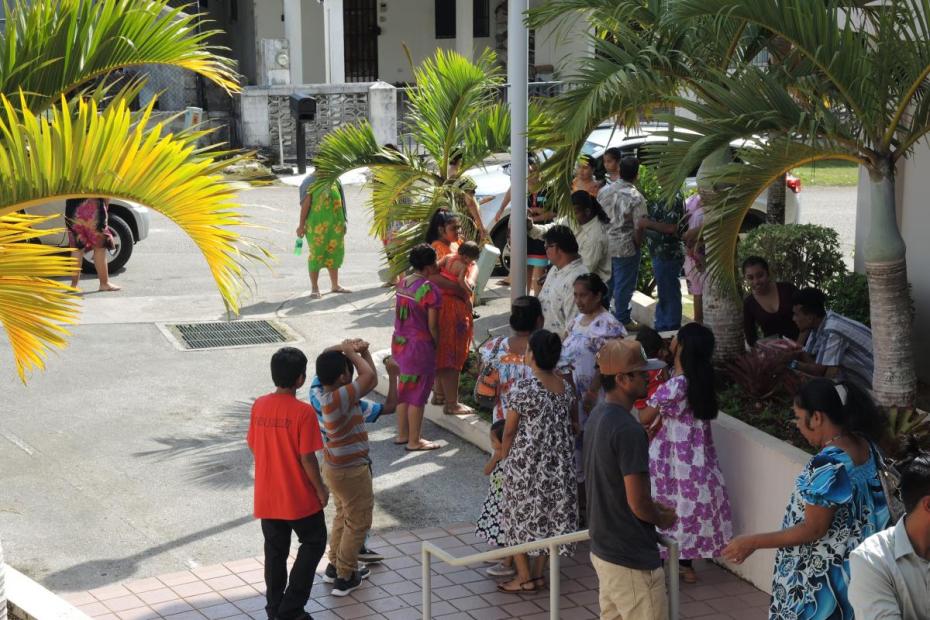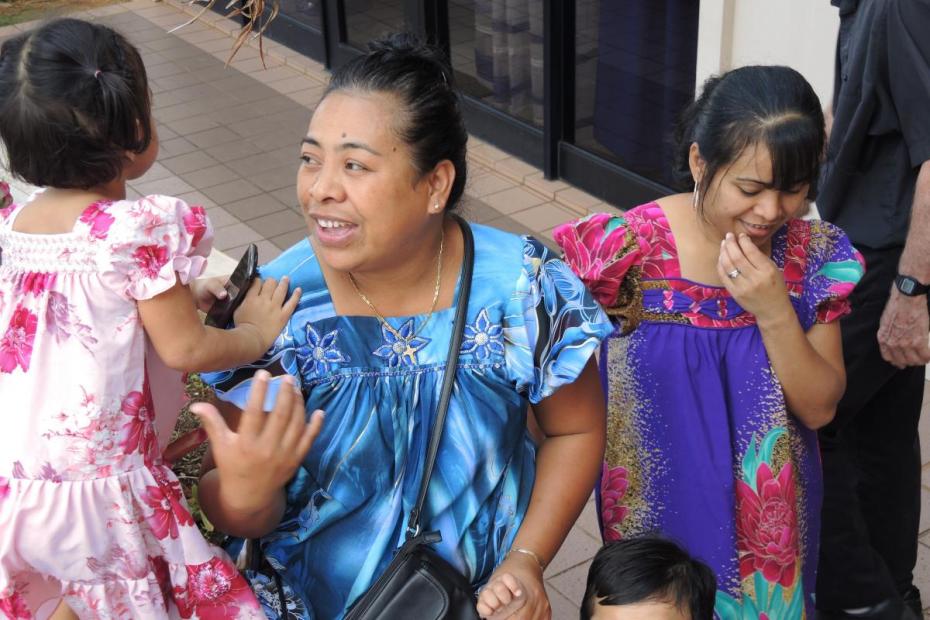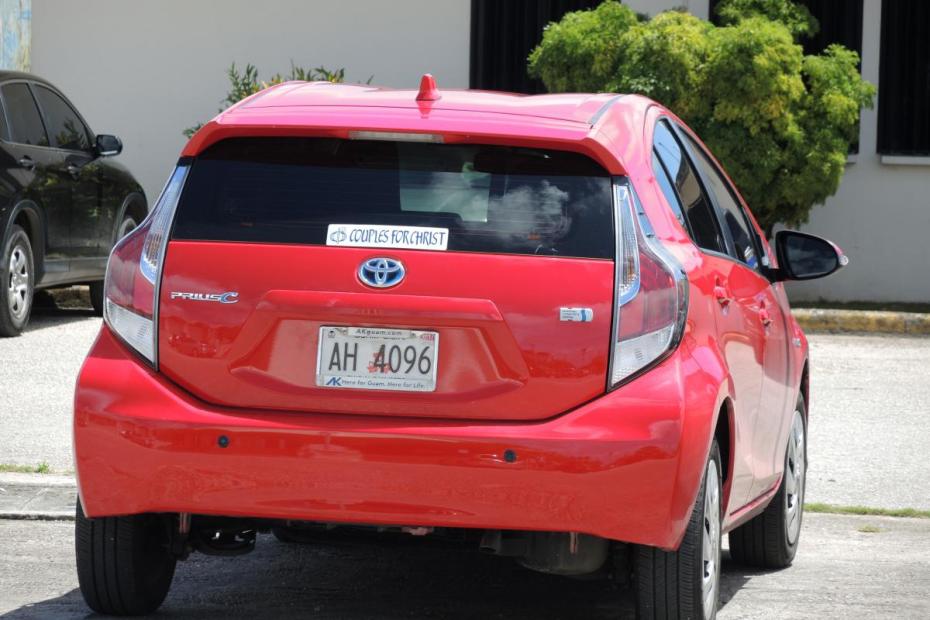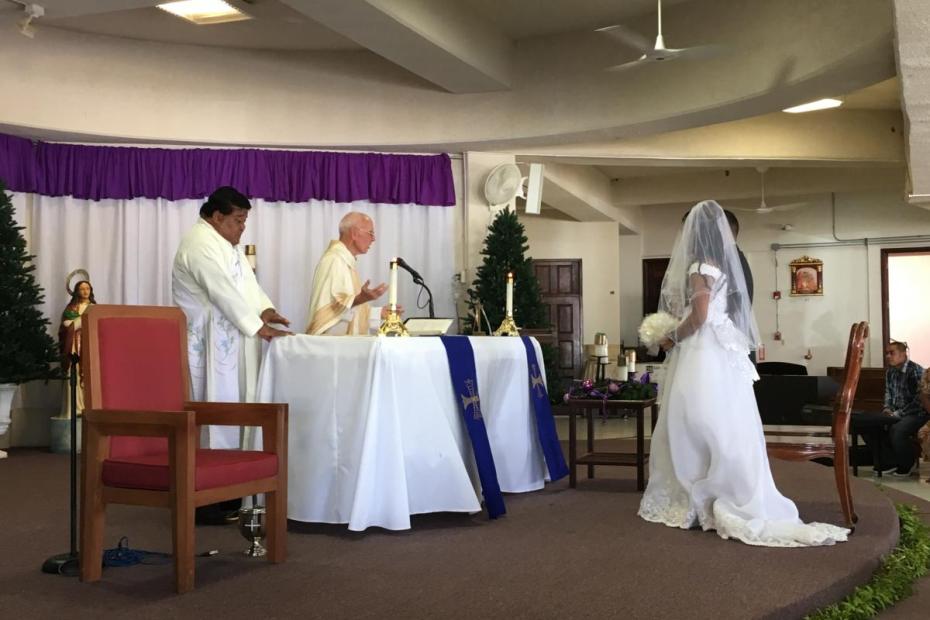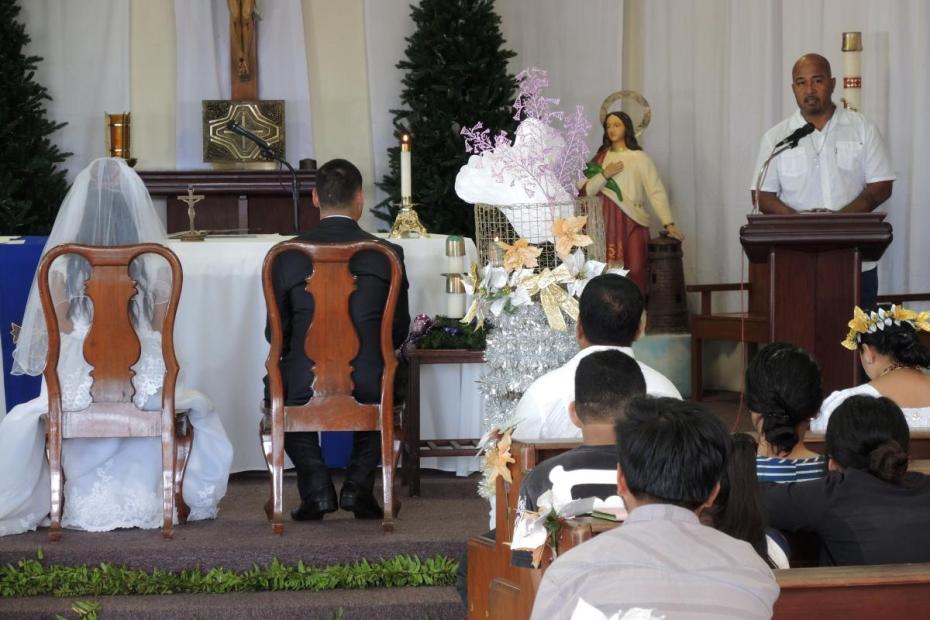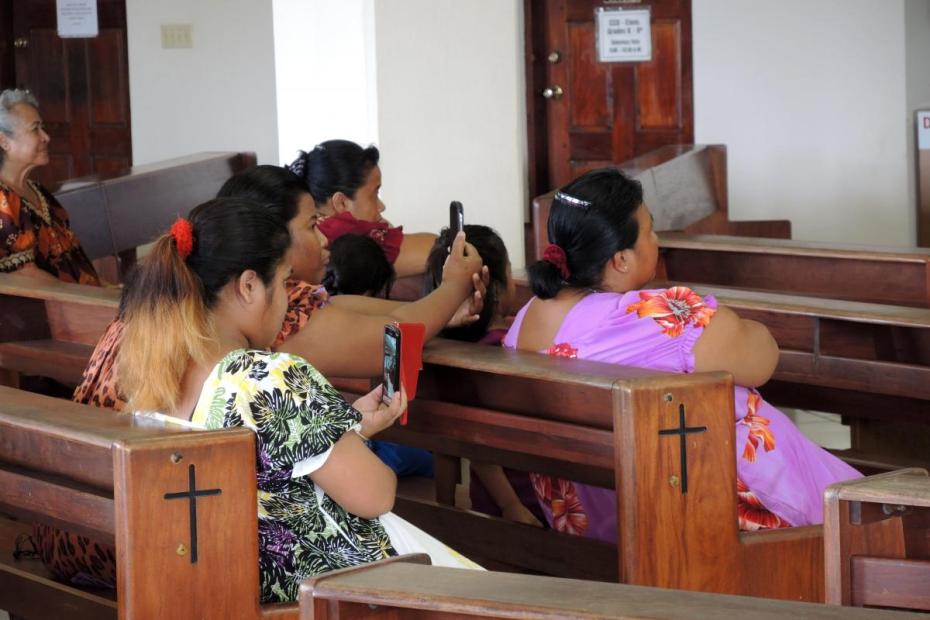The history of Guam and the perspectives of the native Chamorro people have been impacted by immigration and global encounters over 350 years. That process continues today in a variety of ways, including through in- and out-migration. As a result, Chamorros are a minority on their own island today. In the 2010 census, 37% of islanders identified as Chamorro, and 6% identified as Chamorro and something else.1
Filipinos constitute the second largest ethnic grouping on the island today — 26% of the population according to the 2010 census.2 The influx is said to be potentially even more impactful in Catholic parishes. Some parishes reported that Filipinos constitute half of the parishioners. In light of that, it is a challenge, they said, to figure out how to welcome Filipinos without having their ways supplant Chamorro ones. Filipinos were among those who first brought Christianity to the islands. Those who came and stayed during the centuries of galleon trade were woven into island life so that their progeny became Chamorro. But a newer wave of immigrants, the first of whom were brought in to help rebuild the island beginning in the 1950s, do identify as Filipino. Many of those immigrants stayed and became the first links in a migration chain that has continued to bring new family members.
One Filipino, who loves his native land and plans to return there eventually, reported, “Guam is the ideal Philippines… The weather is the same. The trees, the environment, the same… and no traffic. This is the Philippines that we want, we dream of.”
A number of Filipino priests have also come to Guam to help minister to Filipino and Chamorro communities alike. Filipino groups like El Shaddai and Couples for Christ have a small presence in Guam. Both priests and lay people interviewed in Guam asserted that it was important to ensure that Chamorros retain a prominent space in the Church in Guam, and that Filipino forms — and Filipino fervor — don’t simply overtake Chamorro leadership and cultural practices. Filipinos do have space to come together to celebrate events such as the Santo Niño feast, or the Misa de Gallo on Christmas morning. Filipinos are important participants and leaders in the life of many parishes as well, but the parishes are said not quite to have “become” Filipino.
Micronesians on Guam
The number of Micronesians has also grown markedly in the last two decades. Chuukese and other islanders have moved seeking better educational and work opportunities, and a better standard of living. Under the laws of compact between the Federated States of Micronesia and the United States, Micronesians can move freely to Guam and work there. Since Guam is the first stop on almost any flight from Micronesia, and a much more prosperous island, it has been an attractive place to migrate. In the 2010 census there were 11,230 Chuukese — more than one-fifth the population of Chuuk — living on Guam, plus 2,248 Pohnpeians and 1,263 Yapese. In all, people from the Federated States of Micronesia constitute almost 10% of the population now. An additional 2,563 have migrated from the Republic of Palau. Immigrants from these countries were never present in significant enough numbers to challenge the larger cultural balance on the island, but their integration into island life has posed challenges.
Clergy, deacons, and lay catechists provide opportunities for worship in each of these peoples’ languages. The Chuukese have weekly Sunday Masses and other services at one of the larger of the island’s churches, Santa Barbara, and the Pohnpeians have one at Santa Bernadita. The Chuukese community that is somewhat spread out on Guam, so for many Chuukese, in addition to being an opportunity for worship, church is one of the most important opportunities to meet friends and family, to gather news and to see who from Chuuk has come to Guam or left. Women dress in Sunday mumus for the occasion, and many people arrive an hour or two early for Mass, or stay around after for a long time to socialize quietly. One Chuukese Catholic young person similarly noted that church and Chuukese church-related youth groups provide one of the primary opportunities to get together. The Chuukese youth group sponsors an annual retreat, and an anniversary day that features team competitions of speeches and songs. The youth group visits the sick and prays with them, and does some community service.
One could say that the socialization needs created by this new context give added impetus to church participation, but one deacon said that he found Chuukese Catholic life to be less animated on Guam than in Chuuk, precisely because the population is dispersed. Village life provided a context for more vibrant and frequent participation, he said.
Many Chuukese have difficulty finding work and/or adapting to the work ethos of Guam, and some migrants lack preparedness to care for themselves without public assistance. In much of Chuuk, people live at a more subsistence level: fishing, farming and sharing resources within families and communities, but Guam’s economy is almost entirely market oriented. Other challenges are more cultural, and no less significant, deriving from differences between Chuukese and Guamanian culture, though the islands are little more than hour away from each other by air.
On Chuuk, communities are tightly organized and social expectations about respect and deference are intricate and clear to everyone in the community. Guam’s culture also emphasizes respect, but does so in a much different way than in Chuuk. Guam is much more individualistic than Chuuk. As one interviewee said, “There’s a real freedom here to be a nonconformist.”
The social mechanisms that ensure obedience and social cohesion on Chuuk are weakened on Guam. Interviewees indicated that it is harder here to discipline children in the framework of Chuukese traditions of deference that they grew up with, which leaves some parents at a loss. Children talk back to their parents in a way that would not happen at home, and children raised in Guam expect their parents to treat them like Guamanian children would be treated. Family violence is said to be a problem among Chuukese. One seasoned observer suggested that this was enabled by the nuclear model, insofar as on Guam there are fewer kin in a household to interfere.
The expectations for men are different in Guam than Chuuk, and some migrants from Chuuk are said not to be prepared. On Chuuk, men traditionally move onto their wife’s family’s land and have particular assigned roles in supporting the family, on land the wife’s family would always own. On Guam, men have to find a house or property to rent or buy, and are expected to be breadwinners or co-breadwinners.
One Chuukese interviewee said that living in Guam undermined the longstanding norms that made it ethically obligatory to look after the good of the whole clan. Cultural adjustment means having to live by new rules, rules that would have seemed morally problematic to Chuukese not too long ago. “They have their own families, and we have our own…Coming here you have to really be protective and you have to think about paying your own rent and finding a job. You cannot really rely on your [relatives]… Back home it’s kind of more appropriate. But here we stay, I think we have to follow the Western culture. You have to survive on your own.”
Such thinking, though it might seem right and moral to Americans and some others, is more disruptive than they might realize. The whole clan’s ability to help regulate the behavior of young people is diminished, and passed to the nuclear family, which may or may not be equipped to carry out the task on its own.
Family and land ownership norms are changing on Chuuk as well, especially on the capital island, Weno, undermining the old norms of sharing household food resources with kin who need it. Western readers should not conclude that the family is under severe stress in the way it is often said to be in the West. Family is construed in very different ways in traditional Chuukese culture than in the West, and is under different kinds of stress. Like people elsewhere, Chuukese who worry about social problems often ascribe those problems to changes in the family structure. However, in contrast to Western narratives, the stories that Chuukese interviewees told about the decline of the family, and the rise of social problems that came with it, were problems resulting from the shift to the nuclear family, not about the decline of the nuclear family.3
According to interviewees, including Chuukese, there are tremendous challenges in the Chuukese community on Guam. A far disproportionate number of Chuukese men are in jail. While most are quite law-abiding and peaceful under normal circumstances, when drunk, “they have no control,” one Chuukese man said, and have committed a variety of violent crimes that put many in jail and that tarnish the Chuukese community’s reputation in Guam. Chuukese and Chamorros alike expressed great anxiety over it. Alcohol has also caused similar difficulties in Chuuk as well, so the problem is not simply an outcome of migration. It may have contributed to experiences of marginalization and isolation in the church in Guam.
One Catholic Chuukese woman interviewee who is involved in her parish was disappointed by a number of small ways that Chamorro and other Guamanians segregated her and other Chuukese, or questioned her work or presence in various places and instances in her parish. She thought that the same questions would not have arisen were she Chamorro or white or Filipina.
Cases of violence ought not define the Chuukese community. In most settings, Chuukese are remarkably gentle and respectful people. Certainly violence under the influence of alcohol has contributed to stigmatization of Chuukese here. The issues arose insofar as they repeatedly came up as responses to questions about sin in the world, and where interviewees most perceived it. Unlike interviewees in other cultures, what came to mind when these interviewees talked about sin was not sex, or poverty and injustice, or bribery and corruption.
Forthcoming entries about Micronesia, especially for Chuuk, along with the video on this page of the large and quite engaged communal Advent Reconciliation service in the Pohnpeian community, make a case that reconciliation plays an outsize role in defining religion in Micronesians’ lives — not simply as a ritual for the individual, but as a way of restoring communities and relationships in the wake of sin and violence.
Chamorros in mainland U.S.A. and Hawaii
Many Chamorros, and some Guam-born children of Filipinos, have migrated to the mainland of the United States. As U.S. citizens, there are no barriers for Guam citizens to migrate to the mainland and Hawaii.
In the 2010 census, more than 88,000 mainland Americans identified as Chamorro, and almost 60,000 more people identified as Chamorro in combination with some other heritage.4 Chamorros on the mainland far outnumber the Chamorro population of Guam, where there were just under 60,000 Chamorros in the same census, and just under 10,000 who identified as Chamorro and something else. In 1980, just over 30,000 people in the United States identified as “Guamanian” Chamorro was not yet a category on the census. In recent decades, emigration has made Chamorros a minority in their own island church, even as it has left them a tiny minority in the mainland church.
The biggest concentration of Chamorros is in California, where just over 24,000 people identified as Chamorro in 2010, plus another 20,000 who identified as part-Chamorro. Washington state had the next largest population. Just under 10,000 identified as Chamorro. Texas, followed with about 6,600. In 32 states and the District of Columbia, the Chamorro population was fewer than 1,000 (lower than 1,600 including people who partially identified as Chamorran).5 While many do seek to continue Chamorro religious practice and traditions, this is often difficult in places where the community is small or diffuse.
In a large survey of Asian and Pacific Islander Catholics in the U.S.A., only 22% of Chamorrans and Micronesians (in reporting survey data, the report lumped them together) reported that their parish had “hosted a program on [their] ethnic or cultural group,” and 39% said that their parish had “hosted a multicultural Mass.”6 The survey, which was not randomized and therefore cannot speak to the experience of all Chamorro Catholics in the United States, relied primarily on respondents who had a connection to a parish. Among those respondents, the devotional quality of Chamorro religious practice carried over to the United States. Devotional practices continued to be “very important” for two-thirds of respondents, and “somewhat important” for one-quarter; 76% said they had participated in a Rosary or novena in the last month, compared to 22% who had participated in a Catholic education class or Bible study, or 27% in a parish social outreach.7 Food remained important: almost half said they had participated in a communal meal/potluck in the last month.8
- 1U.S. Census Bureau, 2010 Census of Population and Housing Demographic Profile Summary File: Guam. Table GU8, n.p., last accessed April 17, 2018, http://cnas-re.uog.edu/wp-content/uploads/2015/10/KGI_2010-Guam-Demographic-Profile-Study.pdf
- 2U.S. Census Bureau, 2010 Census of Population and Housing Demographic Profile Summary File: Guam chart GU8, n.p., last accessed April 17, 2018, http://cnas-re.uog.edu/wp-content/uploads/2015/10/KGI_2010-Guam-Demographic-Profile-Study.pdf
- 3This argument was manifest during site visits to Chuuk, and will be described in a forthcoming entry on that island atoll.
- 4U.S. Census Bureau, “Profile of the Chamorros in the United States,” 2010 Census of Population and Housing, Summary File 2, April 2012. Last visited April 18, 2018. http://cnas-re.uog.edu/wp-content/uploads/2015/10/KGI_2010-Guam-Census-Profile-of-the-Chamorros-in-the-United-States.pdf
- 5U.S. Census Bureau, “Profile of the Chamorros in the United States,” 2010 Census of Population and Housing, Summary File 2, April 2012. Last visited April 18, 2018. http://cnas-re.uog.edu/wp-content/uploads/2015/10/KGI_2010-Guam-Census-Profile-of-the-Chamorros-in-the-United-States.pdf
- 6Tricia C. Bruce, Jerry Z. Park, and Stephen M. Cherry, “Asian and Pacific Island Catholics in the United States: A Report Prepared for the United States Conference of Catholic Bishops Secretariat for Cultural Diversity in the Church,” October 2015, 15, 54, http://www.usccb.org/issues-and-action/cultural-diversity/asian-pacific-islander/demographics/upload/API-Catholics-in-the-US-Report-October-2015.pdf
- 7Bruce, Park, and Cherry, “Asian and Pacific Island Catholics in the United States," 29-30, 38-39.
- 8Bruce, Park, and Cherry, “Asian and Pacific Island Catholics in the United States," 36.
